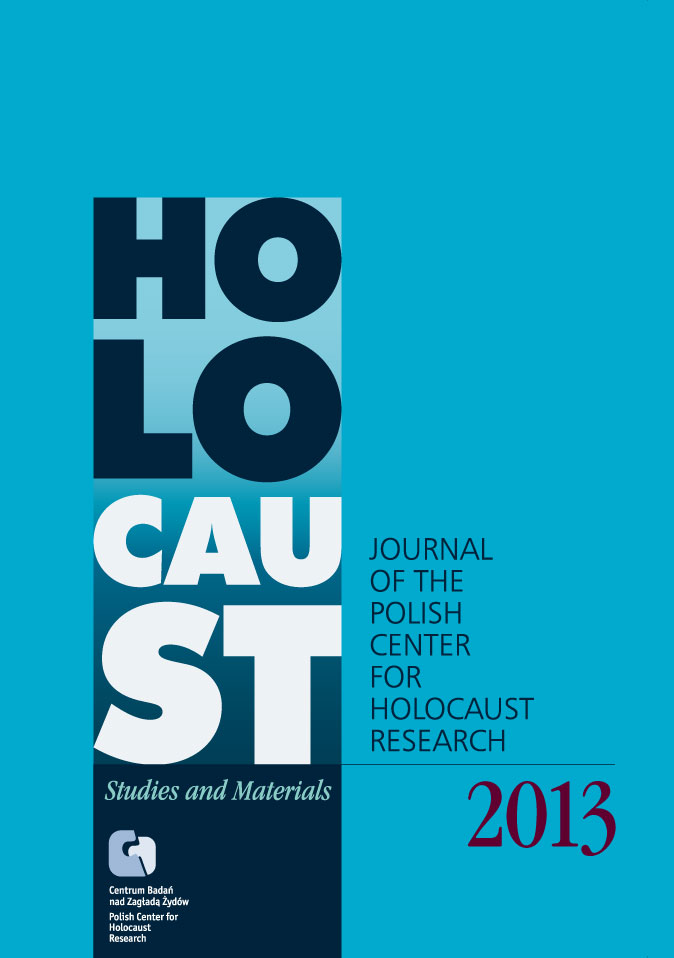Miriam Chaszczewacka’s Diary
Zagłada Żydów. Studia i Materiały, Nr Holocaust Studies and Materials (2013), Strony: 52`1-562
Data zgłoszenia: 2020-12-13Data publikacji: 2013-02-20
 https://doi.org/10.32927/zzsim.838
https://doi.org/10.32927/zzsim.838
Abstrakt
Diary of Miriam Chaszczewacka, a teenage resident of Radom. She wrote it since August 1939 – she started on the eve of the Third Reich’s attack on Poland – until the end of October 1942, when she was killed during the liquidation of the ghetto. Written in Polish, conceived as a letter to the future generations, Miriam’s diary shows the daily life in the ghetto and the extermination of its population based on the example of Radom. Her diary entries are mostly spontaneous notes of a young girl writing about her life. But she also describes the deteriorating conditions of the life in the ghetto and the general political situation. This
is a dramatic record of the increasing awareness of the inevitably approaching death.
Licencja
Prawa autorskie (c) 2013 Autor&"Zagłada Żydów. Studia i Materiały"

Utwór dostępny jest na licencji Creative Commons Uznanie autorstwa 4.0 Międzynarodowe.
https://creativecommons.org/licenses/by/4.0
Czasopismo publikowane jest w standardzie Diamond Open Access na licencji CC-BY-4.0 Deed - Uznanie autorstwa 4.0 Międzynarodowa - Creative Commons
Inne teksty tego samego autora
- Feliks Tych, Pamiętnik Miriam Chaszczewackiej , Zagłada Żydów. Studia i Materiały: Nr 9 (2013)
- Feliks Tych, Barbara Engelking, O ukrywaniu się po „aryjskiej stronie” z Feliksem Tychem rozmawia Barbara Engelking , Zagłada Żydów. Studia i Materiały: Nr 1 (2005)
- Feliks Tych, Pamięci dr Ruty Sakowskiej, badaczki Holokaustu , Zagłada Żydów. Studia i Materiały: Nr 7 (2011)
Podobne artykuły
- Anna Bikont, „Nie trzeba było domu palić, tylko Żydów wyprowadzić i pozabijać” , Zagłada Żydów. Studia i Materiały: Nr 7 (2011)
- Michał Kowalski, "Wokół nas morze ognia' , Zagłada Żydów. Studia i Materiały: Nr 19 (2023)
- Adam Kopciowski, Przemoc antyżydowska w powojennej Polsce w świetle ksiąg pamięci , Zagłada Żydów. Studia i Materiały: Nr 14 (2018)
- Nawojka Cieślińska-Lobkowicz, Śladami nieznanych przedwojennych żydowskich kolekcjonerów i właścicieli dzieł sztuki , Zagłada Żydów. Studia i Materiały: Nr 17 (2021)
- Dariusz Libionka, Prześladowcy Żydów przed Wojskowym Sądem Specjalnym Komendy Głównej AK w 1944 r. , Zagłada Żydów. Studia i Materiały: Nr 15 (2019)
- Aleksandra Bańkowska, Jan Láníček, Jan Lambertz (red.), More than Parcels: Wartime Aid for Jews in Nazi Camps and Ghettos , Zagłada Żydów. Studia i Materiały: Nr 19 (2023)
- Wojciech Mądry, Zagłada ludności żydowskiej i polskiej w Miechowie widziana oczyma nastolatka. Nieopublikowane wspomnienia Andrzeja Wędzkiego z lat 1939–1945 , Zagłada Żydów. Studia i Materiały: Nr 17 (2021)
- Barbara Engelking, Źródło wszystkich źródeł. O czterech warszawskich tomach Archiwum Ringelbluma , Zagłada Żydów. Studia i Materiały: Nr 10 (2014)
- Jan Grabowski, Klaus-Michael Mallmann, Martin Cüppers, Półksiężyc i swastyka. III Rzesza a świat arabski , Zagłada Żydów. Studia i Materiały: Nr 5 (2009)
- Marta Grudzińska, Rutka Goldman, Szkolny pamiętnik , Zagłada Żydów. Studia i Materiały: Nr 19 (2023)
<< < 12 13 14 15 16 17 18 19 20 21 22 23 24 25 26 27 28 29 30 31 32 33 34 35 36 37 38 39 40 41 42 43 44 45 46 47 48 49 50 51 52 53 54 55 56 57 58 59 60 61 > >>
Możesz również Rozpocznij zaawansowane wyszukiwanie podobieństw dla tego artykułu.
 English
English
 Język Polski
Język Polski




